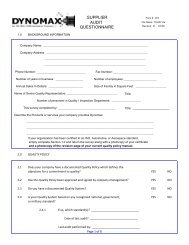You also want an ePaper? Increase the reach of your titles
YUMPU automatically turns print PDFs into web optimized ePapers that Google loves.
Likewise, a <strong>spindle</strong> cooling jacket indirectly removes heat created by the moving rotor and<br />
internal winding that has transferred to the stator. The drawback is, of course, that the cooling<br />
media cannot contact the inside of the motor, particularly the ends of the windings where heat is<br />
greatest. In addition, the cooling water has to be pumped through a separate heat exchanger,<br />
adding to the cost.<br />
Depending upon the <strong>spindle</strong> design, estimated cooling system capacity can vary. The next charts<br />
show informative relations between heat dissipation and cooling water flow quantity:<br />
SPINDLE MOTOR COOLING RECOMMENDATIONS<br />
Heat Removal Requirements Flow Inlet Liquid Temp. to<br />
kW<br />
l/min<br />
Spindle (°C)<br />
5.0 12.0<br />
5.5 13.5<br />
7.0 18.0<br />
4.0 10.0<br />
26 °C<br />
6.5 16.5<br />
7.5 19.0<br />
12.5 32.0<br />
A <strong>spindle</strong> can be furnished with internal passages for thermal bearing control:<br />
THERMAL BEARING CONTROL RECOMENDATIONS<br />
Heat Removal Requirements Flow Inlet Liquid Temp. to<br />
kW<br />
l/min<br />
Spindle (°C)<br />
0.50<br />
0.75<br />
2.0 30<br />
Another possible system involves using air as the cooling medium.<br />
This system blows cool outside air simultaneously around the<br />
stator and through the motor. It allows for a very effective method<br />
of cooling both the inside and outside of the integral <strong>spindle</strong> motor.<br />
The effectiveness of this system allows the motor to run cooler,<br />
thereby generating more power. This system effectively keeps the<br />
heat away from the machine resulting in reduced dimensional<br />
thermal effects.<br />
The cold outside air is typically sucked through a filter from the<br />
rear of the machine through the motor. The exhaust typically goes<br />
to the top of the machine, blowing the warm air away from it.<br />
Figure 26.<br />
Air cooling<br />
- 26 -



